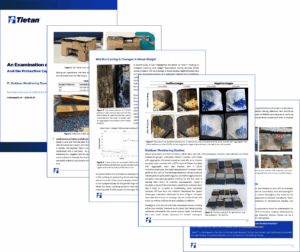And the Protective Capabilities of an Asphalt Coating
Ft. Outdoor Weathering Experiment, Moisture Content Fluctuation Study
Railway Innovative Solutions, LLC
Download the Technical Paper
Table of Contents
- Executive Summary
- Introduction
- Understanding How Moisture Affects Wood Ties
- Impact of UV Radiation on Degradation of Wood Surfaces
- Current Wood Treatment Methods and The Need for Supplementary Protection
- Introducing Tietan: a Formulated Asphalt Coating as Supplementary Tie Protecting Solution
- Performance Attributes of Tietan
- Outdoor Weathering Studies
- Summary of Benefits and Conclusions
- References
Executive Summary
Railroad professionals are well aware that wood rail ties inevitably deteriorate and require costly replacements. While chemical preservatives are the go-to option to extend rail tie operational lifetime, maintenance-of-way professionals have noticed alarming rates of tie deterioration, notwithstanding the type of treatment these ties have undergone. Consequently, engineers have recently sought additional solutions to the issue of expensive wood tie turnover, but have yet to find a definitive answer to improve this situation.

To address this issue, Railway Innovative Solutions, LLC has formulated an asphalt-based coating under the commercial name Tietan. Tietan eliminates the threat of UV and minimizes water damage from the top surface of the tie. It is applied hot and seeps into existing openings in the wood prior to cooling, forming a durable and flexible membrane that will bond with solvent-based treatments like creosote, copper naphthenate, and DCOI. The hot asphalt is immediately covered with aggregate for slip resistance. Over time, the engineered asphalt flexes with the natural expansion and contraction of wood, ensuring a complementary protective layer to extend the service life of wood ties.
This coating has recently demonstrated major reductions in the impact of weathering on wood, whether applied to untreated or preservative-treated nondurable hardwoods such as red oak, sweetgum, and southern yellow pine, to name a few. Outdoor weathering shows that untreated ties can deteriorate rapidly. Water and UV radiation are a threat to wood’s mechanical integrity, where their combined effect with temperature fluctuations accelerates both dimensional changes and accumulation of internal stresses. Tietan can reduce levels of water uptake by 34% on average, offering the tie a more stable environment where moisture content, stress and strain on the wood fibers can be minimized, thus reducing the development of cracks, splits, and checks.
See the Research Results
